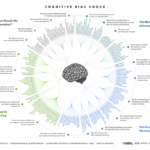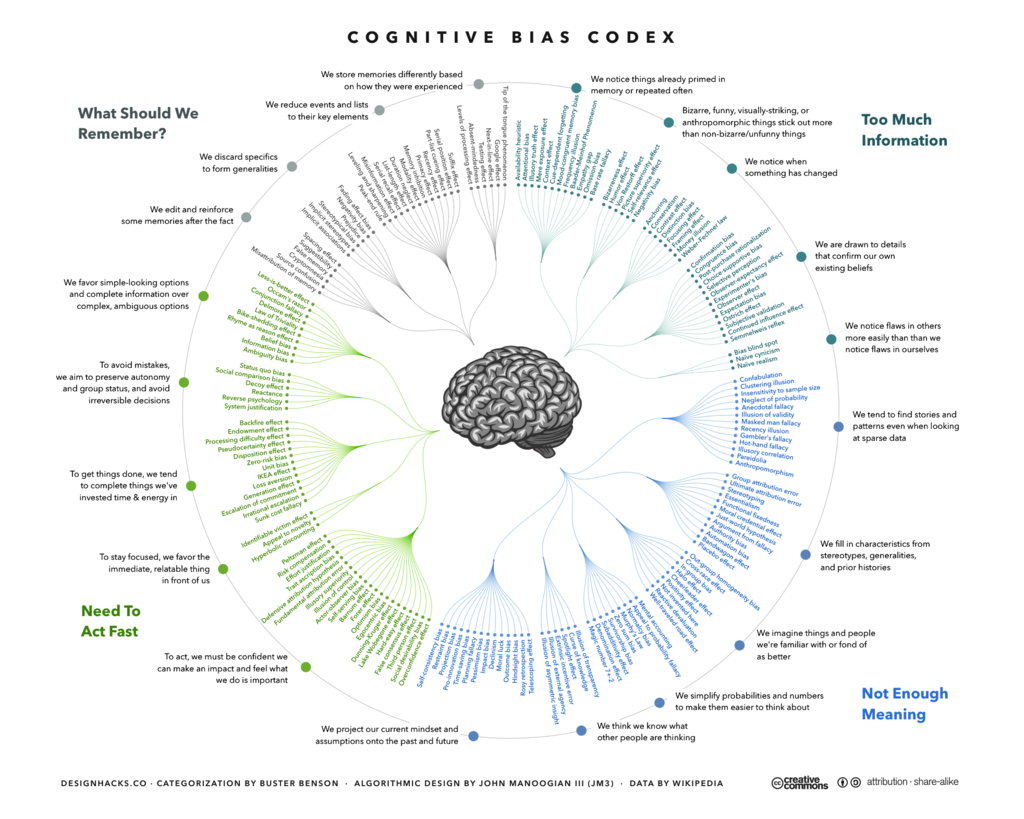2020 is pretty challenging so far – and I am writing this relatively objectively. The events of 2020 are challenging (individually we might have varied experiences, of course). As we enter the second half of this year I am noticing a dominating pattern in my client work, personal development and conversations around me: biases.
The list of cognitive biases is long. Most of us are go through life unaware of many of those biases – they play out automatically. We live convinced that our grounded reality is completely objective and true, oftentimes forgetting that is predominantly true to…us. We all have individual perspectives and experiences that shape our worldview, affect our judgement and our actions. There is a lot, of course, that we can collectively agree on – we seem to have unified definitions for many things. I would never argue about royal blue for example. However, as soon as we sit in one room, in two chairs and start talking we might both realise that our definition of fear, anger, grief, love or joy might be very different.
Why do I mention this – I guess it is a dominant theme in the current discussions about racism, LGBTQ+ rights and the fight with the global pandemic. How those discussions and conversations affect each of us might be collective and systemic, but also individual, so we need to be very careful when making judgements about each other. I am not advocating for the tolerance of racist and extremist behaviours, quite the contrary. However, in the long term thinking, I do think we need to work towards better and more inclusive systems by understanding our differences, our varied points of views and our individual biases.
I am at the beginning of an exciting journey – I am writing a book about digital wellbeing. I am writing a lot about our negative bias towards digital technologies and the impact of it on our wellbeing. I am also generally spending a lot of time learning about various shades of our own biases. Dr Pragya Agarwal writes in her fantastic book, “Sway: Unravelling Unconscious Bias” about many types of biases and their impact on our everyday life. It’s fascinating and a bit shocking too! Finding out just how deeply embedded are those inner mechanisms can be scary, but here is the key learning for me: change is only possible if we embrace our own vulnerability, admit our own mistakes and accept that we can do better.
Both in coaching and in counselling change can be painful, challenging and also very healing and empowering. We know this from our work with clients, but also from our experience of being clients. So why is it so hard to change? Well, turns out that in itself is a bias as well: one called status quo bias. It is a form of preference we might have in which we prepare the current stats of affairs and would do anything to prevent change:
“The current baseline (or status quo) is taken as a reference point, and any change from that baseline is perceived as a loss. Status quo bias should be distinguished from a rational preference for the status quo ante, as when the current state of affairs is objectively superior to the available alternatives, or when imperfect information is a significant problem. A large body of evidence, however, shows that status quo bias frequently affects human decision-making. Status quo bias should also be distinguished from psychological inertia, which refers to a lack of intervention in the current course of affairs. For example, consider a pristine lake where an industrial firm is planning to dump toxic chemicals. Status quo bias would involve avoiding change, and therefore intervening to prevent the firm from dumping toxic chemicals in the lake. Conversely, inertia would involve not intervening in the course of events that will change the lake.” (via Wikipedia)
This means that oftentimes when we think we are making a rational choice to remain true to ourselves, to our culture, to our system or way of doing things and avoid change, we might be automatically acting based on this bias. So what can we individually do about it?
It’s not all bad news. It’s important to know that there is such bias and we all might be operating this way now and again. We all might have various ways of working with this bias. I personally have a simple way – which resembles a little the reversal test used in identifying resistance to change: whenever I feel that things continuously repeat themselves and I do not see progress or change I wish to move on to, I stop acting based on my rational decision making and try (safely) to do exactly the opposite.
Recently that is what helped me start running (you can see the explanation of my journey here). I was feeling passive, sad and guilty so I started runs with an attitude of active engagement, joy and celebration of simple steps: out of the door, on to the pavements, forwards. On a small scale, doing the opposite might seem irrelevant, but once you start practising this approach you can scale it up to more complex biases, including racism or are other forms of systemic thinking.
2020 is challenging indeed, but if we all start reflecting, looking deeper under the surface of our individual experiences, biases and systems, I am sure we will find a way to move gently but steadily towards individual and collective change.
What do you think? Let me know.


